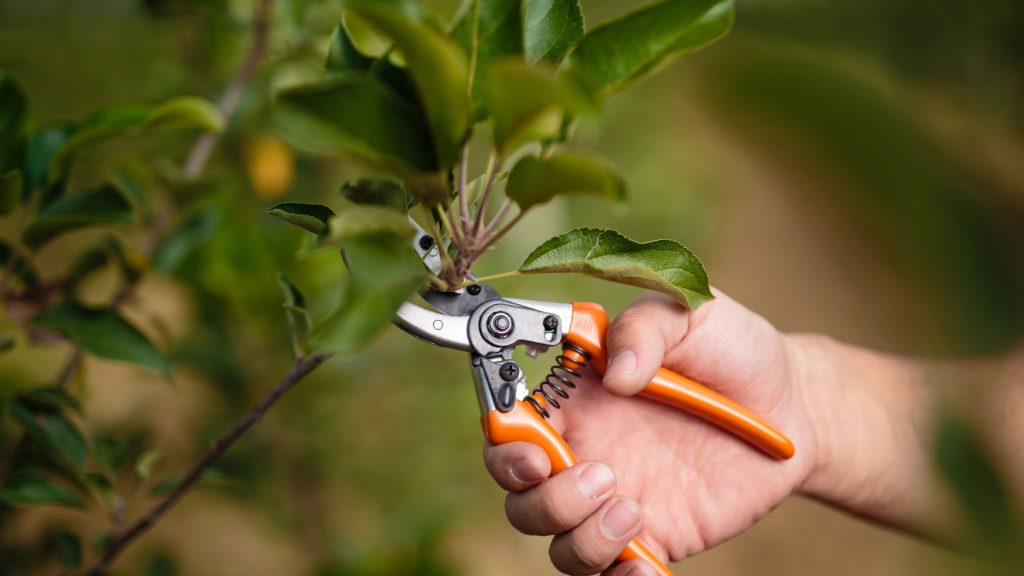
Key Takeaways
- Purpose of Pruning: Pruning is essential for removing dead or diseased wood, enhancing tree shape, and ensuring strong structure.
- Types of Pruning: Thinning, crown reduction, and crown cleaning are the primary pruning techniques, each serving different purposes.
- Pruning Guidelines: Avoid removing more than 25% of the tree’s canopy in a single session to prevent stress and potential health issues.
- Pruning Young vs. Mature Trees: Young trees should be pruned lightly to shape them, while mature trees require the removal of dead or hazardous branches.
- Seasonal Considerations: Different tree species may need pruning at specific times, such as during dormant seasons or after blooming.
- Benefits: Proper pruning improves tree health, aesthetics, and safety, while improper techniques can lead to structural problems and increased susceptibility to pests and diseases.
Tree pruning is a crucial aspect of maintaining healthy and aesthetically pleasing trees. However, many homeowners and gardeners find themselves wondering, “How much should you prune a tree?” The right amount of pruning can boost a tree’s health, shape, and growth, but over-pruning or under-pruning can lead to problems. This comprehensive guide will delve into the essentials of tree pruning, helping you strike the perfect balance for a thriving tree.
Understanding Tree Pruning
Pruning involves removing specific parts of a tree—such as branches, buds, or roots—to promote overall health and growth. The primary goals of pruning are to remove dead or diseased wood, enhance the tree’s shape, and ensure it maintains a strong structure. Proper pruning can improve sunlight penetration, air circulation, and reduce the risk of pest infestations.
Types of Pruning
- Thinning: This technique involves removing selected branches to reduce the density of the tree’s canopy. Thinning allows more light to reach the inner branches and improves air circulation. It is especially beneficial for mature trees that have developed a dense canopy.
- Crown Reduction: This method reduces the size of the tree’s crown while maintaining its natural shape. Crown reduction is typically done to manage tree height and spread, making it suitable for trees near buildings or power lines.
- Crown Cleaning: This involves removing dead, diseased, or crossing branches to improve the overall health of the tree. Crown cleaning is a common practice to prevent the spread of disease and to eliminate potential hazards.
How Much Should You Prune a Tree?
The amount of pruning required can vary based on the tree species, its age, and its overall health. However, a general guideline is to avoid removing more than 25% of the tree’s canopy in a single pruning session. Removing too much foliage can stress the tree and make it more susceptible to disease and pests.
- Pruning Young Trees
For young trees, the focus should be on shaping the tree and establishing a strong framework. Prune to remove any competing branches and to encourage a single central leader. Light pruning is generally recommended, allowing the tree to grow naturally while guiding its shape.
- Pruning Mature Trees
Mature trees require a different approach. Focus on removing dead, diseased, or damaged branches, as well as any that pose a risk to structures or people. Crown thinning can be beneficial for mature trees to reduce wind resistance and improve overall health.
Implications of Pruning
Pruning has several implications for the tree and its surrounding environment. Proper pruning can enhance a tree’s aesthetic appeal and safety, but incorrect techniques can lead to structural issues or health problems. For instance, heavy pruning can cause the tree to produce numerous water sprouts, which are weak and susceptible to breakage.
Benefits of Correct Pruning
- Improved Health: Regular pruning helps remove dead or diseased branches, reducing the risk of infection and promoting overall tree health.
- Enhanced Aesthetics: Pruning can improve the appearance of the tree, shaping it to complement the landscape and adding visual appeal.
- Increased Safety: By removing hazardous branches, you can prevent potential accidents and damage to property.
Insights and Considerations
When deciding how much to prune, it’s essential to consider the tree’s species and growth habits. Some trees, like maples and birches, are best pruned during the dormant season to avoid sap loss. Others, such as flowering trees, may need pruning after their blooming period to maintain optimal shape and health.
Common Misconceptions
A common misconception is that more pruning equals better tree health. In reality, excessive pruning can harm the tree, leading to stress and a weakened structure. It’s important to follow best practices and avoid over-pruning, which can have detrimental effects.
For professional tree pruning services, contact Above All Trees located in Conyers, GA. You can reach them at (770) 922-5356 for expert advice and assistance in maintaining healthy and aesthetically pleasing trees.
Conclusion
Finding the right balance in tree pruning is crucial for maintaining the health and appearance of your trees. Remember that a general rule is to avoid removing more than 25% of the canopy in one session. By understanding how much should you prune a tree and following proper techniques, you can ensure your trees remain strong and beautiful.
FAQs
Q: How much should you prune a tree?
A: Generally, avoid removing more than 25% of a tree’s canopy in a single pruning session to prevent stress and health issues.
Q: What are the main types of tree pruning?
A: The main types of pruning are thinning, crown reduction, and crown cleaning, each serving to improve tree health, shape, and safety.
Q: When is the best time to prune a tree?
A: The best time to prune depends on the tree species. Some trees are best pruned during the dormant season, while others should be pruned after blooming.


